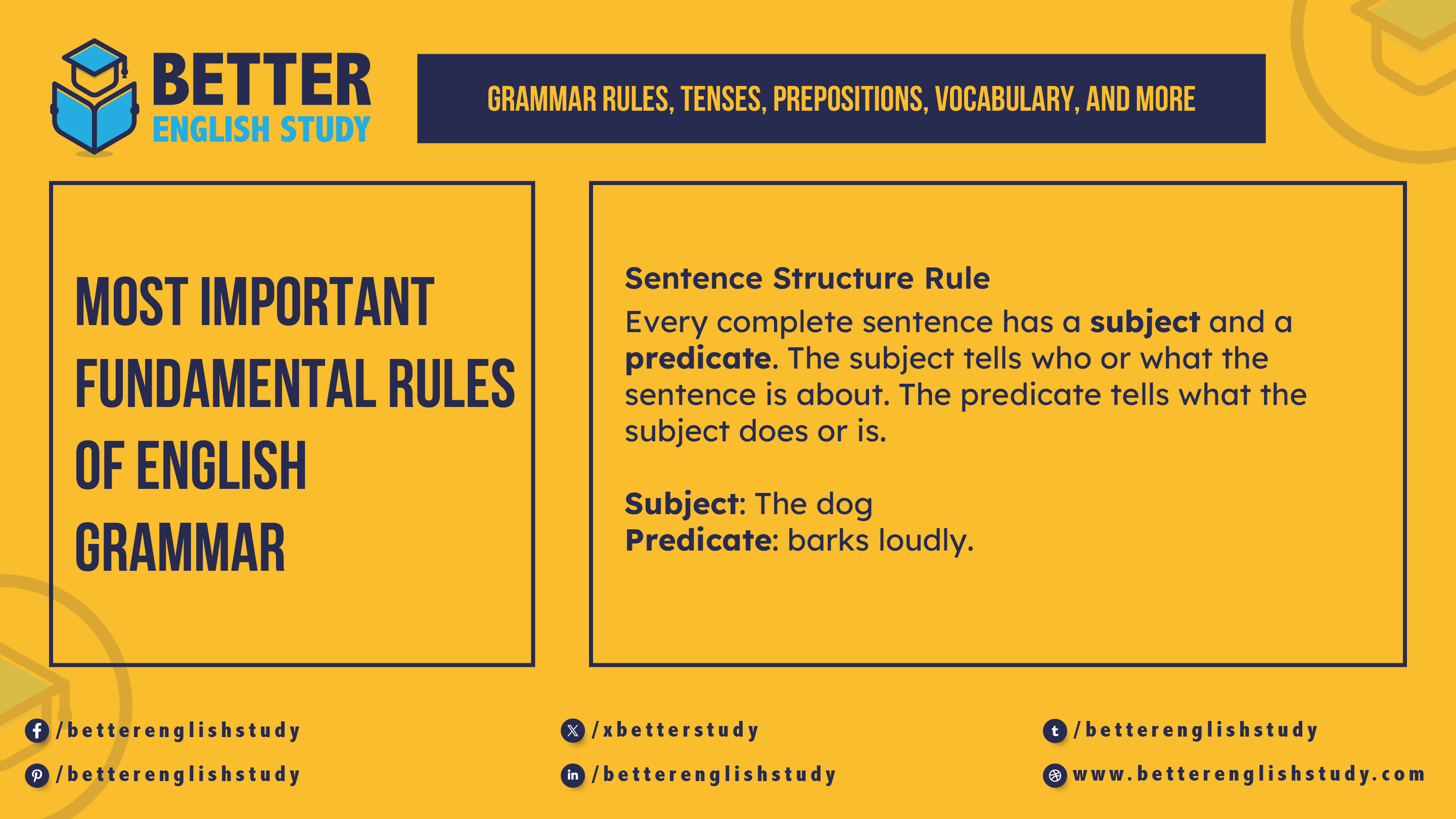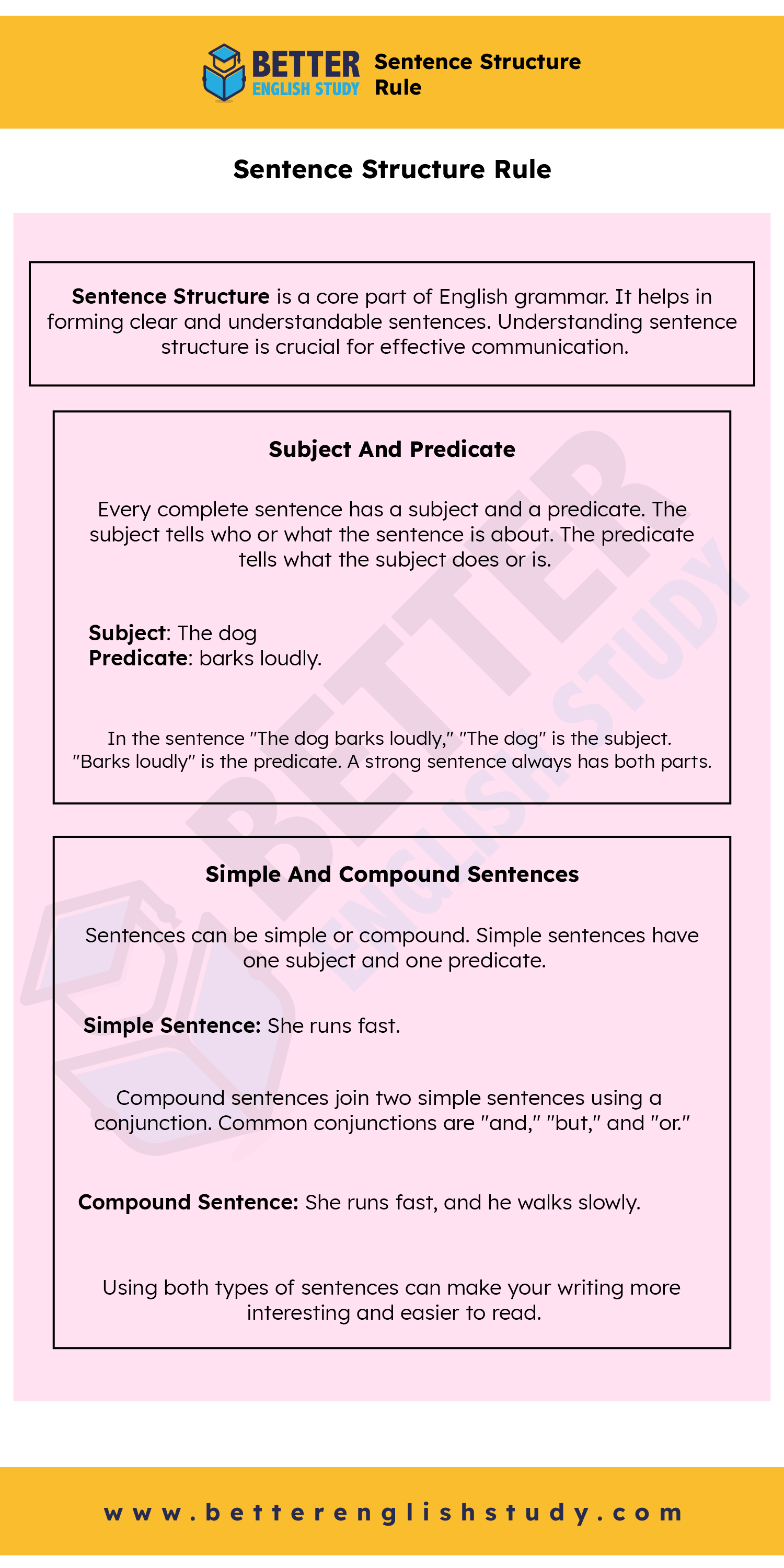
Grammar forms the backbone of any language, including English. Mastering its fundamental rules is essential for clear and effective communication. English grammar helps in structuring sentences, making them understandable.
Subject-verb agreement ensures that subjects and verbs match in number and person. Proper use of tenses indicates the time of action. Correct word order maintains the logical flow of sentences. Understanding these rules can greatly improve your writing and speaking skills. Whether you’re a student, a professional, or an enthusiast, knowing these basics is invaluable.
1. Sentence Structure
Sentence Structure is a core part of English grammar. It helps in forming clear and understandable sentences. Understanding sentence structure is crucial for effective communication.
a) Subject And Predicate
Every complete sentence has a subject and a predicate. The subject tells who or what the sentence is about. The predicate tells what the subject does or is.
- Subject: The dog
- Predicate: barks loudly.
In the sentence “The dog barks loudly,” “The dog” is the subject. “Barks loudly” is the predicate. A strong sentence always has both parts.
b) Simple And Compound Sentences
Sentences can be simple or compound. Simple sentences have one subject and one predicate.
- Simple Sentence: She runs fast.
Compound sentences join two simple sentences using a conjunction. Common conjunctions are “and,” “but,” and “or.”
- Compound Sentence: She runs fast, and he walks slowly.
Using both types of sentences can make your writing more interesting and easier to read.
2. Parts Of Speech
Understanding the parts of speech is crucial for mastering English grammar. They are the building blocks of sentences. Each part of speech plays a specific role.
a) Nouns And Pronouns
Nouns are words that name people, places, things, or ideas. Examples include cat, city, and happiness.
Pronouns replace nouns to avoid repetition. Examples are he, she, and they.
| Type | Examples |
| Nouns | apple, dog, school |
| Pronouns | I, you, it |
b) Verbs And Adjectives
Verbs show actions or states of being. Common verbs include run, is, and write.
Adjectives describe nouns and pronouns. They provide more detail. Examples are happy, blue, and tall.
- Verbs: jump, eat, think
- Adjectives: green, small, interesting
Using these parts of speech correctly improves your writing. It makes your sentences clearer and more interesting.
3. Tenses
Tenses are a key part of English grammar. They help us understand when actions happen. This section will focus on the Past, Present, and Future tenses. We will also look at Perfect and Continuous tenses.
a) Past
The past tense describes actions that have already happened. For example, “He walked to the store.” This means the action is finished. There are different forms of past tense:
- Simple Past: “She played soccer.”
- Past Continuous: “They were playing soccer.”
- Past Perfect: “She had played soccer.”
- Past Perfect Continuous: “They had been playing soccer.”
b) Present
The present tense describes actions happening now. For example, “He walks to the store.” This means the action is ongoing. There are different forms of the present tense:
- Simple Present: “She plays soccer.”
- Present Continuous: “They are playing soccer.”
- Present Perfect: “She has played soccer.”
- Present Perfect Continuous: “They have been playing soccer.”
c) Future
The future tense describes actions that will happen. For example, “He will walk to the store.” This means the action is yet to come. There are different forms of future tense:
- Simple Future: “She will play soccer.”
- Future Continuous: “They will be playing soccer.”
- Future Perfect: “She will have played soccer.”
- Future Perfect Continuous: “They will have been playing soccer.”
d) Perfect And Continuous Tenses
Perfect tenses indicate completed actions. For example, “She has finished her homework.” This means the action is complete. Continuous tenses indicate ongoing actions. For example, “She is finishing her homework.” This means the action is still happening. Combining these can show actions over time:
| Tense | Example |
| Past Perfect Continuous | “She had been studying for hours.” |
| Present Perfect Continuous | “She has been studying for hours.” |
| Future Perfect Continuous | “She will have been studying for hours.” |
4. Subject-verb Agreement
Subject-verb agreement is one of the most important fundamental rules of English Grammar. It ensures that subjects and verbs in a sentence match in number. This rule is crucial for clear and effective communication. Let’s dive into its key aspects.
a) Singular And Plural Subjects
Singular subjects take singular verbs, while plural subjects take plural verbs. For example:
- Singular: The cat runs fast.
- Plural: The cats run fast.
In these examples, “cat” is singular and uses “runs.” “Cats” is plural and uses “run.”
b) Compound Subjects
Compound subjects joined by “and” usually take a plural verb. For instance:
- John and Mary are friends.
Here, “John and Mary” together form a plural subject, so the verb is “are.”
If compound subjects are joined by “or” or “nor,” the verb agrees with the nearest subject:
- Either John or his friends are going.
- Neither the teacher nor the students were late.
In the first sentence, “friends” is nearest, so “are” is used. In the second, “students” is nearest, so “were” is used.
| Rule | Example |
| Singular subject, singular verb | The dog barks. |
| Plural subject, plural verb | The dogs bark. |
| Compound subject with “and” | John and Mary are here. |
| Compound subject with “or/nor” | Neither the cat nor the dogs are sleeping. |
Understanding these rules helps you write clear sentences. Always match the verb to the subject. This ensures your writing is correct and easy to read.
5. Articles
Understanding articles is crucial in mastering English grammar. Articles help specify and clarify nouns. They are tiny words but hold significant value in sentences.
a) Definite And Indefinite Articles
There are two main types of articles in English: definite and indefinite articles.
- Definite Article: “The” is the definite article. It points to a specific noun.
- Indefinite Articles: “A” and “An” are indefinite articles. They point to any noun, not a specific one.
| Article | Usage |
| The | Used for specific nouns |
| A | Used for general nouns starting with consonant sounds |
| An | Used for general nouns starting with vowel sounds |
b) Usage Rules
Here are some basic rules for using articles:
- Use “the” with specific nouns: The cat on the roof is mine.
- Use “a” before words starting with consonants: A dog barked at me.
- Use “an” before words starting with vowels: An apple a day keeps the doctor away.
- Do not use articles with uncountable nouns: Water is essential for life.
Follow these rules to improve your English grammar. Articles are simple yet powerful tools in writing. They bring clarity and precision to sentences.

6. Prepositions
Prepositions are essential in English grammar. They link nouns, pronouns, and phrases to other words. They show relationships of time, place, direction, and more. Understanding prepositions helps in forming clear and correct sentences.
a) Time And Place Prepositions
Time prepositions include words like at, on, and in. These prepositions specify when something happens.
- At: Used with precise times (e.g., at 5 o’clock).
- On: Used with days and dates (e.g., Monday, July 4th).
- In: Used with months, years, centuries, and long periods (e.g., in June, in 2020, in the 21st century).
Place prepositions include words like under, over, between, and next to. These prepositions specify where something is located.
- Under: Below something (e.g., under the table).
- Over: Above something (e.g., over the rainbow).
- Between: In the middle of two things (e.g., between the chairs).
- Next to: Beside something (e.g., next to the door).
b) Prepositional Phrases
Prepositional phrases start with a preposition and end with a noun or pronoun. They add more detail to sentences.
| Prepositional Phrase | Function |
| At the park | Specifies location |
| On the table | Specifies place |
| In the morning | Specifies time |
| Before the meeting | Specifies time |
Understanding prepositions and prepositional phrases enriches your grammar skills. They make your sentences clear and precise.
7. Conjunctions
Conjunctions are words that connect clauses, sentences, or words. They help in forming complex sentences and making the text more coherent. In English grammar, conjunctions are essential for linking ideas smoothly. Understanding the different types of conjunctions is crucial for mastering English grammar.
a) Coordinating Conjunctions
Coordinating conjunctions are used to join two or more independent clauses. These conjunctions include for, and, nor, but, or, yet, and so. They are often remembered using the acronym FANBOYS.
- For: Explains reason or purpose. Example: “I stayed home, for it was raining.”
- And: Adds one thing to another. Example: “She likes apples and oranges.”
- Nor: Adds a negative idea to another negative idea. Example: “He doesn’t drink coffee nor tea.”
- But: Shows contrast. Example: “He is tall, but she is short.”
- Or: Presents an alternative. Example: “Do you want tea or coffee?”
- Yet: Introduces a contrasting idea. Example: “She is kind, yet firm.”
- So: Shows result. Example: “It was late, so we left.”
b) Subordinating Conjunctions
Subordinating conjunctions connect an independent clause with a dependent clause. They include words like because, since, unless, although, and if.
| Conjunction | Function | Example |
| Because | Shows cause | “She left early because she was tired.” |
| Since | Shows time or reason | “Since he was late, we started without him.” |
| Unless | Shows condition | “You can’t go unless you finish your homework.” |
| Although | Shows contrast | “Although it was raining, they went out.” |
| If | Shows condition | “If you study, you will pass.” |
Understanding these rules helps in creating more complex and meaningful sentences. Mastering conjunctions enhances both writing and speaking skills.
8. Punctuation
Punctuation helps readers understand the meaning of sentences. It shows where one idea ends and another begins. Let’s explore some basic punctuation rules in English grammar.
a) Periods And Commas
Periods and commas are basic punctuation marks. They help to clarify sentences. Periods show the end of a sentence. Every sentence needs a period at the end.
Commas separate parts of a sentence. Use a comma to list items, like apples, oranges, and bananas. Also, use a comma before conjunctions like “and” or “but”. For example, “She loves dogs, but she is allergic.”
b) Colons And Semicolons
Colons introduce lists, quotes, or explanations. For example, “He needs: a pencil, a notebook, and an eraser.”
Use a colon to introduce a quote: “She said: ‘Hello!'”
Semicolons connect related sentences. They show a closer relationship than a period. For example, “I have a test tomorrow; I need to study.”
Semicolons can also separate items in a complex list. For example, “The meeting included: John, the manager; Lisa, the assistant; and Tim, the intern.”
| Punctuation Mark | Usage | Example |
| Period | End a sentence | She went home. |
| Comma | Separate items or ideas | He bought apples, oranges, and bananas. |
| Colon | Introduce lists or quotes | She said: “Hello!” |
| Semicolon | Link related sentences | It is raining; we will stay inside. |
Remember these rules to improve your writing. Proper punctuation makes your writing clearer.
9. Modifiers
Modifiers are essential components of English grammar. They help add detail and depth to sentences. Modifiers include adjectives and adverbs. These words describe or qualify other words in a sentence. Understanding how to use modifiers correctly is key to crafting clear and engaging sentences.
a) Adjectives And Adverbs
Adjectives describe nouns or pronouns. They provide more information about an object’s size, shape, age, color, origin, or material. For example:
- The blue sky – Here, “blue” is an adjective describing the sky.
- A young cat – “Young” is an adjective describing the cat.
Adverbs modify verbs, adjectives, or other adverbs. They often end in “-ly” and answer questions like how, when, where, and to what extent. For example:
- She sings beautifully – “Beautifully” is an adverb describing how she sings.
- He ran quickly – “Quickly” is an adverb describing how he ran.
b) Comparative And Superlative Forms
Adjectives and adverbs can show different degrees of comparison. These are called comparative and superlative forms.
| Type | Example | Comparative | Superlative |
| Adjective | small | smaller | smallest |
| Adjective | happy | happier | happiest |
| Adverb | quickly | more quickly | most quickly |
| Adverb | well | better | best |
Use the comparative form to compare two items. For example, “She is taller than her brother.”
Use the superlative form to compare three or more items. For example, “She is the tallest in her class.”
10. Pronoun-antecedent Agreement
Understanding the rules of the Pronoun-Antecedent Agreement is vital for clear writing. Pronouns must agree with their antecedents in number, gender, and person. This ensures the sentence is understandable and grammatically correct.
a) Singular And Plural Pronouns
Singular pronouns must match singular antecedents. Plural pronouns must match plural antecedents. This rule helps in maintaining clarity in sentences.
Consider this example:
- Singular: The cat lost its collar.
- Plural: The cats lost their collars.
Using the wrong pronoun can confuse the reader. Always check the number of your antecedent.
b) Indefinite Pronouns
Indefinite pronouns can be tricky. They often appear singular but may require plural pronouns. Common indefinite pronouns include everyone, someone, anybody, and nobody.
Consider these examples:
- Everyone should bring their lunch.
- Someone left their book on the table.
Note that their is used for singular indefinite pronouns. This usage is widely accepted for inclusivity.
| Indefinite Pronoun | Correct Pronoun |
| Everyone | their |
| Someone | their |
| Anybody | their |
| Nobody | their |
Following these rules ensures your writing is clear and correct. Misusing pronouns can lead to confusion. Always match your pronouns to their antecedents.
11. Active And Passive Voice
Understanding active and passive voice is essential. They help in writing clear sentences. Active voice makes sentences direct. Passive voice focuses on the action more.
a) Forming Active Voice
In the active voice, the subject acts. This creates a clear and direct sentence.
- Structure: Subject + Verb + Object
Example:
| Subject | Verb | Object |
| The cat | chased | the mouse |
b) Forming Passive Voice
In the passive voice, the object becomes the subject. The action is emphasized over the doer.
- Structure: Object + Be Verb + Past Participle + (by Subject)
Example:
| Object | Be Verb | Past Participle | (by Subject) |
| The mouse | was | chased | (by the cat) |
12. Direct And Indirect Speech
Direct and Indirect Speech are key elements of English grammar. They help convey what someone has said. They allow us to report speech in two ways: directly or indirectly.
a) Reporting Verbs
Reporting verbs are essential in Direct and Indirect Speech. Common reporting verbs are say, tell, and ask. They introduce the speech. In Direct Speech, we use quotation marks. For example:
In Indirect Speech, we do not use quotation marks. For example:
- She said that she was happy.
Here is a table of common reporting verbs and their usage:
| Direct Speech | Indirect Speech |
| He says, “I am coming.” | He says that he is coming. |
| She says, “You should go.” | She tells him to go. |
| They asked, “Are you coming?” | They asked if he was coming. |
b) Changes In Tense
Changes in tense occur when converting Direct Speech to Indirect Speech. The tense usually shifts one step back. Here are some examples:
- Present Simple to Past Simple: “I eat” becomes “he said he ate”.
- Present Continuous to Past Continuous: “I am eating” becomes “he said he was eating”.
- Present Perfect to Past Perfect: “I have eaten” becomes “he said he had eaten”.
Let’s see this in a table for a better understanding:
| Direct Speech | Indirect Speech |
| She says, “I am happy.” | She said that she was happy. |
| He says, “I have finished.” | He said that he had finished. |
| They say, “We are going.” | They said that they were going. |
Understanding these rules makes reporting speech clear and accurate.
Frequently Asked Questions
What Are The Basics Of English Grammar?
English grammar basics include nouns, verbs, adjectives, and adverbs. Understand subject-verb agreement and proper punctuation. Use correct tense and sentence structure.
What Are The Golden English Grammar Rules?
Use proper punctuation, subject-verb agreement, and consistent tense. Avoid sentence fragments and run-on sentences. Ensure correct use of articles, prepositions, and conjunctions. Use active voice for clarity.
What Are The 5 Key Principles Of English Grammar?
The five key principles of English grammar are subject-verb agreement, proper tense usage, correct punctuation, accurate word order, and appropriate pronoun usage. These principles ensure clarity and coherence in writing. Always check for grammatical accuracy to enhance readability and SEO performance.
How Many Grammar Rules Does English Have?
English has over 100 grammar rules. These rules cover syntax, punctuation, tense, and more. They ensure clear communication.
Conclusion
Mastering these fundamental rules of English grammar is essential for clear communication. These rules help improve your writing and speaking skills. Practice regularly to internalize them. By understanding these fundamentals, you can enhance your confidence in using English effectively.
Keep refining your grammar to excel in both personal and professional settings.
